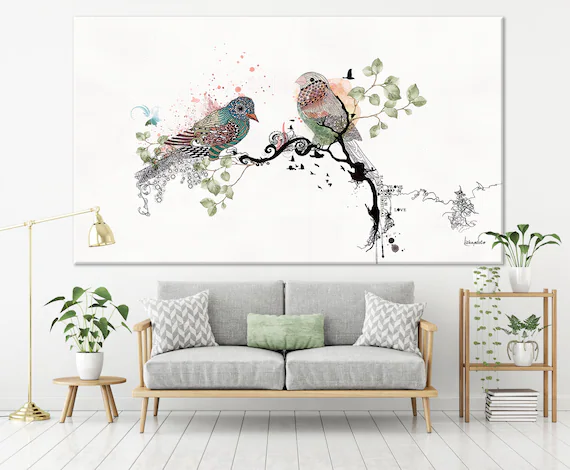
Yet the artworks that grace living room walls can be a dramatic statement of style in themselves, and representing the room’s colour palette can contribute as much to the way the space ‘feels’, so it is worth selecting works that speak to both your design priorities and represent its palette.
Add some texture, like in some string art; or, if you have multiple prints, frame them at regular intervals to create an impressive wall display.
Frame it right
When deciding on artwork for a living-room wall, the frame is as important as the painting itself: it provides the perfect finishing flourish, as well as protecting and enhancing the work, which should be avoided altogether in cheap plastic or craft paper frames that look dated while failing to provide enough reinforcement for pictures of all sizes.
Another good way to create a gallery wall is to hang pieces of similar sizes or similar subject matter together. This creates a sense of a botanical collection. This kind of hang works especially well when you want to complete a larger, horizontal wall, like the space above a fireplace mantel – for best results, pay attention to picture spacing; the difference from one picture to the next needs to be consistent.
Spatial and tonal considerations are always important, of course: a sprawling Impressionist pastoral may look extravagantly out of place in a small apartment marked by chill modernism, and warmth-scorching, blaring yellow needs to avoid tussling with its chilly Arctic nemesis, the dazzling blue. Hang lighting above 18th-century work to best reveal mottled brushstrokes, and situate pieces where natural light and artificial light up the best details and textures.
Choose the right lighting
If your living-room walls feel a bit dull, ensure to enact a lighting policy as the right lighting will make artworks pop and the room feel bigger.
Wall sconces or a chandelier can really help define a gallery wall, or at least large pieces that will benefit from all the extra light source will bring to their scale and colour palette.
Wallpaper lovers, consider an accent wall as a quick way to incorporate pattern; it’s easily changed out if your tastes shift.
Invest in a statement piece
All in all, it is in the details that home decor resides, and art, no matter the size or scale, can illuminate and enhance, can be that final feather to nestle in the cap of an otherwise unremarkable living room.
It’s important that it means something to you and that you are choosing it for that reason: the right work has the power to transform your blank, bare walls into an interior that is yours alone.
Think about the scale of your living room when buying art to hang on the walls – a large canvas looks fantastic as a focal piece above a sofa or by a stairway; smaller canvas works better in an eclectic gallery display.
Don’t be afraid to mix it up
Given the plethora of options when it comes to wall art, adding it into your home decor strategy can seem intimidating. But with a few steps, your search can be simplified. The first step would be to identify the defining aspects of your space – if it is mid-century modern styling, then string art or other geometric shapes would possibly work, but for Scandi-inspired living rooms, pastel or neutral tones and subtle line-work works much better.
Then don’t stick to the straitjacket and be willing to take chances. Put different works together in groupings without worrying that they’re ‘fatal’ mixes. Hang a wacky gallery wall: pairings with several similar themes using multiple different media styles. Abstract ocean with earthy woods/succulents? Absolutely? Mountains work with desert paintings? Yes, indubitably.







